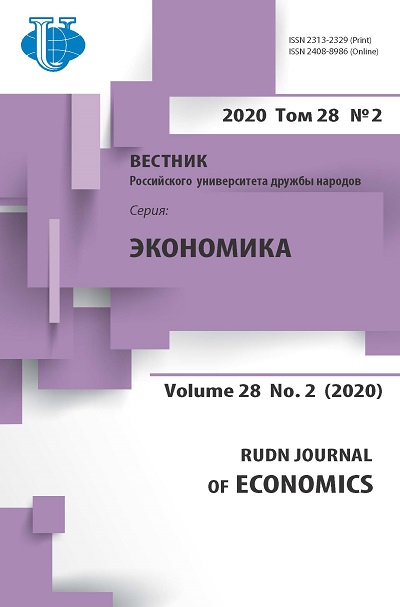Peculiarities of representation on the maps of indicators of socioeconomic development of the Arctic territories
- Authors: Trifonova P.S.1
-
Affiliations:
- Institute of Economics, Ural Branch of the Russian Academy of Sciences
- Issue: Vol 28, No 2 (2020)
- Pages: 347-356
- Section: ECONOMIC GROWTH AND SOCIO-ECONOMIC DEVELOPMENT
- URL: https://journals.rudn.ru/economics/article/view/23900
- DOI: https://doi.org/10.22363/2313-2329-2020-28-2-347-356
Cite item
Full Text
Abstract
The article is devoted to the visualization features on the maps of indicators of the socio-economic development of the Arctic territories. In recent years, issues of the development of the Arctic territories of the Russian Federation have been one of the priority directions for the development of the state. That explains the relevance of research in this area. It is proposed to use modern geographical information systems as a method of displaying socio-economic indicators in space. This choice led to the availability of a large array of data necessary for analyzing the opportunities and priorities of the socio-economic development of the Arctic territories. As an example, an indicator is considered - the payroll of all employees of organizations. According to the presented results, we can conclude that there is a strong differentiation of the Arctic territories by the level of financial security.
About the authors
Polina S. Trifonova
Institute of Economics, Ural Branch of the Russian Academy of Sciences
Author for correspondence.
Email: pol.trifonova2018@yandex.ru
junior researcher of the Center of Strategic Development Areas
29 Moskovskaya St, Ekaterinburg, 620014, Russian FederationReferences
- Drummond, W.J. (2013). GIS as a visualization tool for economic development. Computers, environment and urban systems, 17(6), 469–479.
- Karmanov, A.G., Knyshev, A.I., & Yeliseyeva, V.V. (2015). Geoinformatsionnyye sistemy territorial'nogo upravleniya [Geoinformation systems of territorial management]: A training manual. Saint Petersburg: ITMO University.
- Konovalova, N.V., & Preminina, Ya.K. (2014). Metodologicheskiye osobennosti ekonomicheskogo kartografirovaniya regionov [Methodological features of economic mapping of regions]. Arctic Evironmental Research, (3), 25–30.
- Maliene, V. et al. (2011). Geographic information system: Old principles with new capabilities. Urban Design International, 16(1), 1–6.
- Mark, D.M. et al. (1997). The GIS history project. UCGIS Summer Assembly (pp. 15–21).
- Preobrazhenskiy A.Ya. (1973). Ekonomicheskiye karty v doreformennoy Rossii: Material dlya istorii rossiyskoy ekonomicheskoy kartografii [Economic maps in pre-reform Russia: Material for the history of Russian economic cartography]. Cartographica: International Journal of Geographical Information and Geovisualization, 10(1), 1–46.
- Prokhorova, E.A. (2018). Sotsial'no-ekonomicheskie karty [Socio-Economic Maps]: A Tutorial. Moscow: KDU Publ., Dobrosvet Publ. Retrieved January 25 2020 from https://bookonlime.ru/ node/432/
- Tatarkin, A.I., Zakharchuk, E.A., & Pasynkov, A.F. (2015). Arkticheskiye territorii Rossii: Formirovaniye statisticheskikh rayonov i obosnovaniye vozmozhnostey finansovogo razvitiya [Arctic territories of Russia: Formation of statistical areas and justification of financial development opportunities]. Ekaterinburg.
- Xiao, G., & Shuai, F. (2007). Application of GIS to Regional Economic Analysis [J]. Geospatial Information, 1, 27.
- Zakharchuk, Ye. A., & Trifonova, P.S. (2018). Differentsiatsiya arkticheskikh territoriy po urovnyu finansovoy obespechennosti [Differentiation of the Arctic territories by the level of financial security]. Izvestiya USMU, 4(52), 143–151. doi: 10.21440/2307-20912018-4-143-151.
- Zakharchuk, Ye.A., & Pasynkov, A.F. (2016). Rossiyskaya Arktika: Otsenka i vozmozhnosti finansovogo razvitiya [Russian Arctic: Assessment and Opportunities for Financial Development]. ECO, 5(503), 107–119. doi: 10.30680 / ECO0131-7652-2016-5-107-119.
- Zhukov, V.T. (2015). Sotsial'no-ekonomicheskaya kartografiya [Socio-economic cartography]: A training manual. Moscow: Lomonosov Moscow State University.















